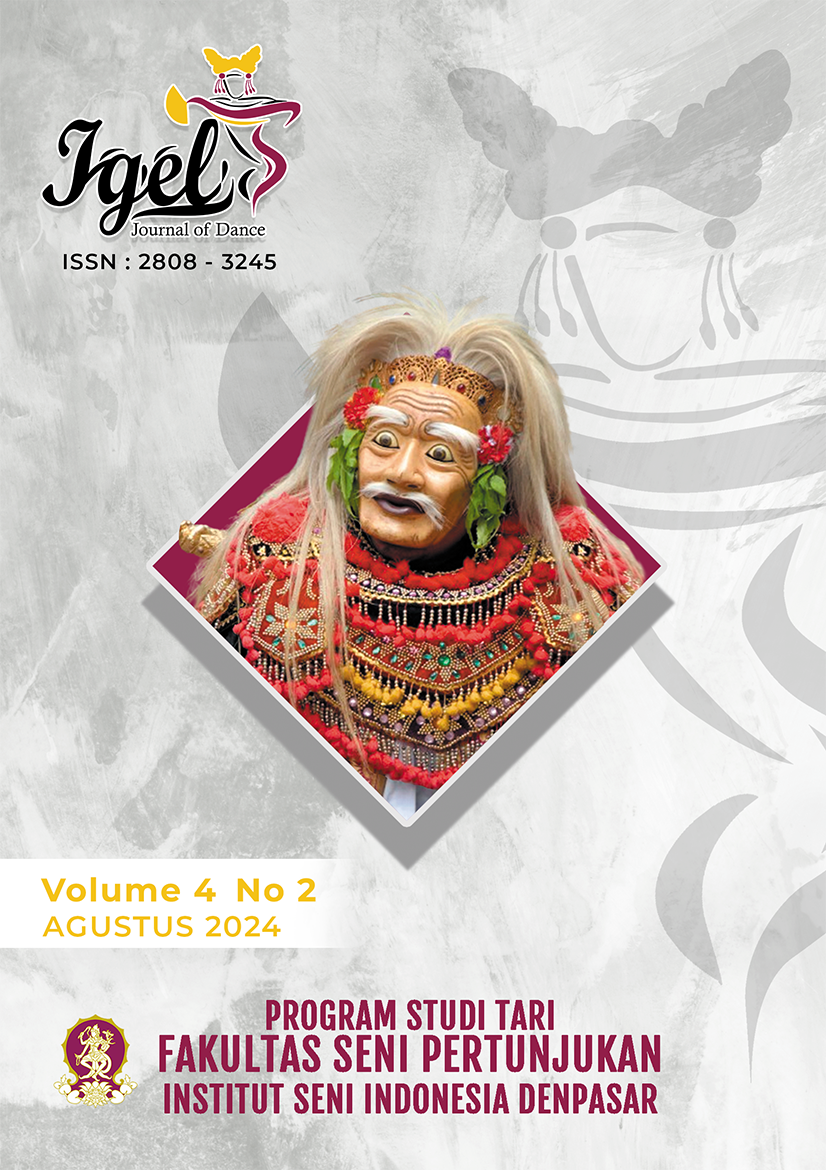Dwaya Rupa Penggambaran Dua Karakter Dalam Satu Tokoh
DOI:
https://doi.org/10.59997/jijod.v4i2.3253Keywords:
Dwaya Rupa, Galuh Candra Kirana, Penciptaan, Panji SemirangAbstract
This article discusses the creation of a new creative dance work that originates from the Panji Semirang story, the search for Galuh Candra Kirana when she disguised herself as Panji Semirang to look for her lost lover. The idea for this dance work is motivated by the phenomenon that exists around that when someone wants to be what other people want in order to be liked or respected by other people, they often forget their own identity. The purpose of creating a dance work. These are: (1) Inviting people to develop their creativity and improve their abilities in the art of dance, to create an original creative work through the processing and development of movement; (2) Become a source of reference for new works that will be created in the future; (3) To contribute to the progress and brilliance of dance creation in collaboration with the Wayan Geria Foundation. The process or stages of creation that are followed include: (1) Ngarencana, (2) Nuasen, (3) Makalin, (4) Nelesin, and (5) Ngebah. This work is realized in the form of a new dance creation consisting of seven female dancers depicting the characters Galuh Candra Kirana and Panji Semirang. The structure of this work is divided into three parts, namely beginning, content, and ending. The dance accompaniment used in this work is Gamelan Selonding with the addition of several instruments such as drums, flute, gentorag, cengceng ricik, and gong. This dance uses modified Balinese dance make-up and a semi-contemporary style fashion concept. The results of the dance creation process were performed at the Natya Mandala Building, Indonesian Institute of the Arts, Denpasar.
References
Cerita, I Nyoman. 2020. Teks dan Konteks Di Balik Seni Pertunjukan Bali, Denpasar-Bali : JAPA.
Dibia, I Wayan. 2008. Seni Kekebyaran, Denpasar : Bali Mangsi Foundation.
Dibia, I Wayan. 2020. Ngunda Bayu Teknik Pengolahan Tenaga Dalam Seni Pertunjukan Bali. Gianyar: Geria Olah Kreativitas Seni (GEOKS)
Djelantik, A.A.M. 2004. Estetika Sebuah Pengantar, Denpasar : STSI Denpasar.
Emoto, Masaru. 2006. The True Power of Water, Badung : MQ Publishing.
Hadi, Y. Sumandiyo. 2007. Kajian Tari Teks dan Konteks. Yogyakarta: Pustaka Book Publisher.
Hadi, Y. Sumandiyo. 2017. Koreografi Bentuk-Teknik-Isi. Yogyakarta: Cipta Media.
Hawkins, Alma M. 1990. Menciptakan Lewat Tari terjemahan oleh Sumandyo Hadi, Yogyakarta: ISI Yogyakarta.
Harymawan, RMA. 1993, Dramaturgi, Bandung : Rosda Karya.
Mardiwarsito, L. 1981. Kamus Jawa Kuna-Indonesia. Ende-Flores: Nusa Indah.
Poerbatjaraka,R.M.NG. 1986. Tjeritera Pandji dalam Perbandingan, Djakarta : P.T. Gunung Agung.
Soedarsono. 1986. Elemen-elemen Dasar Komposisi Tari, Yogyakarta : Lagaligo.
Soerjadiningrat, B.P.A. 1934. Babad lan Mekaring Djoged Djawi, Jogjakarta: Kolf Buning.
Suteja, I Kt. 2018. Catur Asrama Pendakian Spiritual Masyarakat Bali Dalam kekebyaran Sebuah Karya Tari, Denpasar : Paramita.
Yudarta, I Gede. 2022. Sosialisasi Merdeka Belajar-Kampus Merdeka. Denpasar: ISI Denpasar
Additional Files
Published
Issue
Section
License
Copyright (c) 2024 Ni Komang Wiwin Sari Putri

This work is licensed under a Creative Commons Attribution-NonCommercial-ShareAlike 4.0 International License.
Volume 2 Nomor 1, Juni 2022








